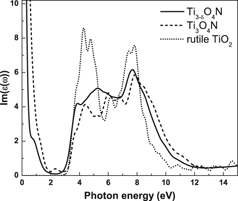Published online by Cambridge University Press: 13 July 2015

Self-energy correction density functional theory local density approximation–1/2 (LDA-1/2) method was successfully applied to predict the electronic structure and optical properties of the N-doped, Ti-vacant Ti3−δO4N oxynitride [G. Hyett et al., J. Am. Chem. Soc.129, 15541–15548 (2007)], which was shown experimentally to be more photocatalytic than titania. The procedure takes into consideration of the two possible types of Ti vacancies (with different numbers of nitrogen and oxygen neighbors) and their formation energies, according to the experimental data on fractional occupancies, with potential effects on the electronic structure and photocatalyst mechanisms analyzed. Different defective model structures were calculated for optimal final configuration, whose optical calculations revealed massive damping in infrared spectrum, while transparency in green region. The band gap determined by our methodology is 2.5 eV, in close agreement to the experimental value of 2.6(1) eV. Results presented in this work represent the first report of an electronic structure modeling of Ti3−δO4N, which is a starting point to help provide an understanding of its photocatalytic activity.